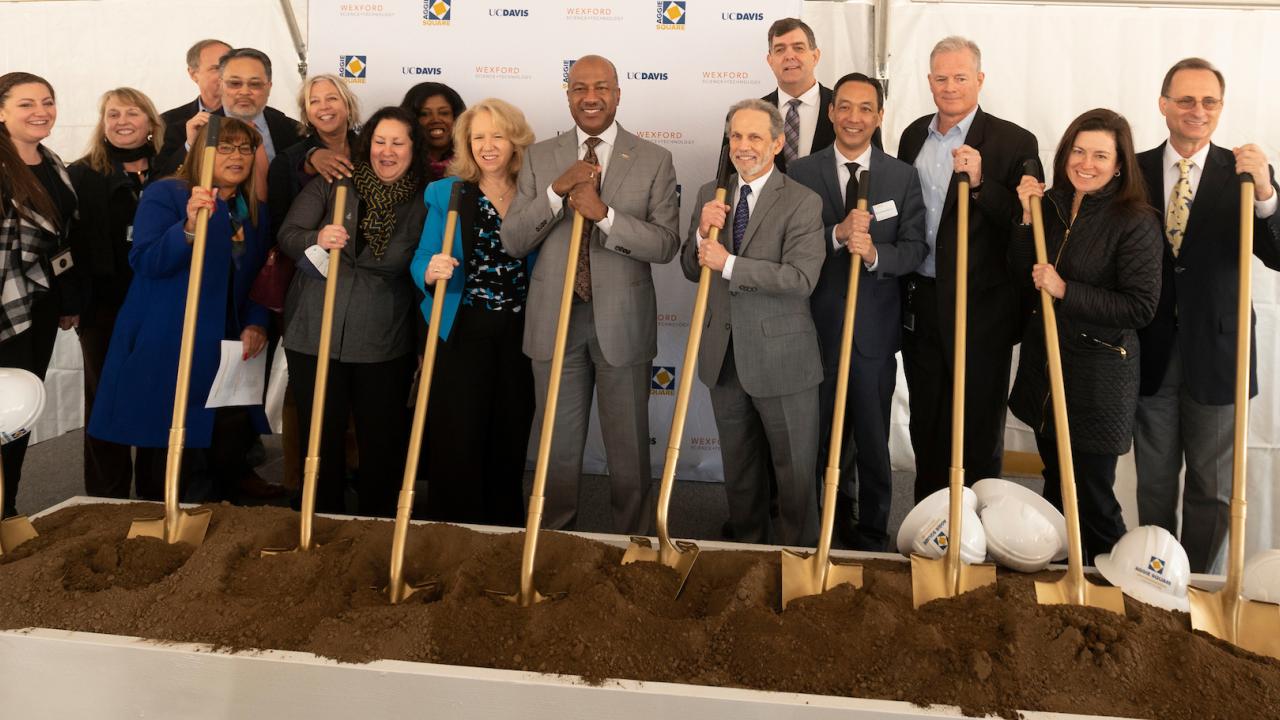
The Groundbreaking: So Many People to Thank
How did we get here? What did it take for the Aggie Square team to reach the crucial threshold of breaking ground on the new UC Davis innovation campus in Sacramento?
There’s a one word answer: teamwork.
And there’s a more complicated answer: the Aggie Square team itself is maybe the most innovative thing about this project. It is charged with making our university more nimble as well as a better partner and neighbor in our region. It fulfills this mission by bringing together experts from across the university, many of whom had never worked together before, all in the name of making something new.
It was amazing at the groundbreaking ceremony to see so many of the people who have collaborated on this project and to think about the relationships that we’ve established along the way. Those relationships needed to be solid enough to start building Aggie Square, and they will need to strengthen further if we are going to construct the innovation infrastructure that will further transform our university.

We’ve been able to reach this point because our team has three key abilities: 1. the ability to partner across university divisions (and beyond the university as well), 2. the ability to cut through bureaucracy (of which our university has a considerable amount), 3. and, most importantly, the ability to see Aggie Square as an opportunity to grow beyond what is expected from UC Davis.
Aggie Square is not a research project or a health campus project or a real estate project, but it has benefited from the hard work of the university’s real estate team, its health campus faculty and staff, and the innovation experts in our office of research. What makes Aggie Square different from old-school innovation research parks is its community focus, which means we’ve needed university inclusivity experts, government and community relations team members, and campus planners. That’s a broad swath of offices across our two campuses, and each of those offices has its own culture, its own way of doing business, and its own role to play.
When a new person joins the Aggie Square team, we all introduce ourselves by describing what we do for the project and then we identify our day jobs, since we all wear more than one hat. (For instance, during my time on the project I’ve also served as English department chair and interim director of the University Writing Program.)
Bring university faculty and staff from diverse offices together on one team and you break the entrenched organizational bureaucracy of the university just a little bit. But in a good way. You also change the behavior of every team member. Planning Aggie Square has required getting out of our comfort zones and asking us to collaborate in new ways with new partners. And that’s even before you start talking about what it's like to work so closely with the city of Sacramento or our developer partner, Wexford Science + Technology. It’s great, don’t get me wrong, but it’s different from chairing an academic department or coordinating a staff unit.
A little discomfort has been a good thing. If our team members hadn’t been willing to get out of their lanes, we would never have been able to negotiate the Community Benefits Partnership Agreement with Sacramento, we would never have been able to bring so many stakeholders together to participate in the design of our new campus, and we would never have been able to show colleagues across both UC Davis campuses how their strategic goals for research, teaching, and community engagement could come to fruition in the Aggie Square campus they’ve helped us design.
These are all big accomplishments, and groundbreaking is providing the Aggie Square team with a chance to reflect on how much work has been involved thus far as the project has developed from our chancellor’s initial vision into a plan that earned the approval of the Board of Regents as well as the support of the city of Sacramento, and that will shortly start to take shape on Stockton Boulevard.
To build Aggie Square means bringing together unique facilities — some of which come from the university, some from our developer, and some from industry and other partners — and these assets will need to be well-tended if they are going to serve our students, faculty, and partners.
We have our work cut out for us, true, but bringing together the planning team has taught us a good deal and we have learned from it. Our goal is to reproduce the success of the cross-functional planning team in collaborating across both campuses to bring the entire university to bear. That kind of organizational innovation will ensure that, through Aggie Square, UC Davis becomes the national model for the 21st century land grant university.
